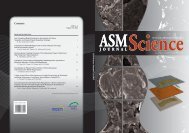Layout 27032008.indd - Portal Rasmi Akademi Sains Malaysia
Layout 27032008.indd - Portal Rasmi Akademi Sains Malaysia
Layout 27032008.indd - Portal Rasmi Akademi Sains Malaysia
- No tags were found...
Create successful ePaper yourself
Turn your PDF publications into a flip-book with our unique Google optimized e-Paper software.
SPECIAL PROJECTSPROJEK KHASProgram <strong>Sains</strong>Angkasawan<strong>Akademi</strong> telah dilantik untuk menguruskan programsaintifi k ini secara kerjasama dengan Agensi AngkasaNegara (ANGKASA). Selepas bertungkus lumus danmerancang selama beberapa tahun, angkasawan<strong>Malaysia</strong>, Dr Sheikh Muszaphar, telah melaksanakanProgram Saintifi k ini dengan jayanya.Pada 10 Oktober 2007, tepat jam 19.22 waktu Baikonur,Soyuz TMA-11 berjaya dilancarkan. Pada hari berikutnya,pasukan teknikal telah kembali ke Moscow. ParaPenyelidik Utama dan jurutera di Pusat Kawalan Misi,Moscow memulakan tugasan kawalan dan pemantauanmisi sebaik Soyuz bercantum dengan fasiliti penyelidikanStesen Angkasa Antarabangsa (ISS). Mesyuaratperancangan diadakan setiap hari dengan pasukanteknikal Rusia untuk memutuskan jadual kerja harianangkasawan <strong>Malaysia</strong>. Selain itu dua sesi komunikasilintasan suara dengan angkasawan tersebut juga diadakan. Lintasan suara ini membolehkan angkasawanmelaporkan tugasan berhubung eksperimen yangtelah mereka jalankan, mengemukakan soalan sertamenerima sebarang arahan yang telah dikemaskini.Semua penyelidikan sains [Protein in Space Activation,Motion Perception, MUSCLE (Low Back Pain), Cancerin Space Activation, MIS Activation, Twisting OrbitalPlatform, Food in Science and Eye Tracking Device(ETD)] termasuk penyelidikan untuk Agensi AngkasaEropah (ESA) dan Agensi Eksplorasi Angkasa LepasJepun telah dijalankan dengan sempurna. Selain ituSheikh Muszaphar juga telah berjaya menyempurnakankerja-kerja membaiki ETD milik ESA.Dr Sheikh Muszaphar telah selamat kembali ke bumisebaik Soyuz TMA-11 mendarat pada 21 Oktober 2007.Kapsul Soyuz telah terbabas dari sasaran asal semasamemasuki ruang angkasa bumi. Ini mengakibatkanSoyuz mengalami daya G yang tinggi dan bergelorasemasa menembusi atmosfera bumi ketika mendarat.Masalah ini timbul kerana gangguan komputer telahmenyebabkan Soyuz mengalami trajektori masukpada sudut yang lebih curam berbanding sudut yangtelah ditetapkan. Meski pun begitu, semua sampelsains terselamat. Sampel-sampel ini termasuk hablurprotein yang agak sensitif juga tidak musnah akibatpendaratan tersebut.The Angkawasan (Astronaut)Science ProgrammeThe Akademy was appointed to manage the scientifi cprogramme with the National Space Agency (ANGKASA).After many years of hard work and planning, the Scientifi cProgramme was fi nally successfully carried out by the<strong>Malaysia</strong>n astronaut (Dr Sheikh Muszaphar).Soyuz TMA-11 was launched successfully at 19:22Baikonur time, on 10 October 2007. The following daythe technical team was fl own back to Moscow. Themission command and monitoring work was startedby the Principle Investigators (PIs) and the engineersat Mission Control Center Moscow on the day of theSoyuz docking with the International Space Station (ISS)research facility. There was a planning meeting helddaily with the Russian technical team in order to fi nalizethe <strong>Malaysia</strong>n astronaut’s schedule for the day. Therewere also two voice-loop communication sessions withthe astronaut every day. This was for the astronauts toreport what they had done on the experiments, ask anyquestions they had and also to receive any updatedinstructions.All the science experiments [Protein in Space Activation,Motion Perception, MUSCLE (Low Back Pain), Cancer inSpace Activation, MIS Activation, Twisting Orbital Platform,Food in Science and Eye Tracking Device (ETD)] wereconducted successfully including the experiments forthe European Space Agency (ESA) and the JapaneseAerospace Exploration Agency. In addition to thatrepair on ESA’s ETD was also successfully conductedby Dr Sheikh Muszaphar.Soyuz TMA-10 landed back on earth on 21 October2007 with the successful return of Dr Sheikh Muszaphar.The Soyuz capsule veered off course from its intendedcontrolled re-entry through the earth’s atmosphere whichresulted in a very rough, high-G descent. The deviationwas caused by a computer glitch that sent the Soyuzon a much steeper descent trajectory than planned. Allthe science samples were successfully recovered. Thisincluded the very fragile protein crystals that survivedthe landing and remained intact.In Pursuit of Excellence in Science 107
















